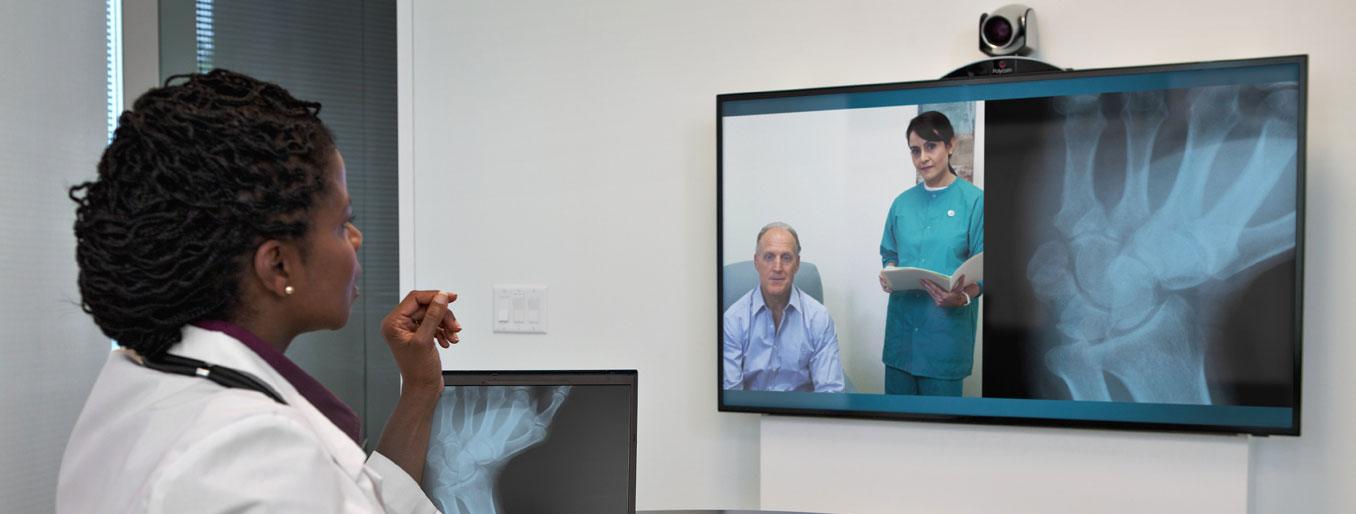Telemedicine is veritably the “next” in healthcare technology and care delivery (Why telemedicine is a must-have). If you are considering investing in telemedicine software for your healthcare organization, you’ll need to look at a technology solution that helps you grow your revenue while being a convenient, user-friendly and effective service that would add value to your patient experience.
If you are in a dilemma about the right software for your practice or wondering what telemedicine is and how it is different from telehealth, then here are a few answers to those commonly asked questions that will help you make your decision.
- What is the difference between telemedicine and telehealth?
While often used interchangeably, the terms ‘telemedicine’ and ‘telehealth’ have a subtle difference. Telemedicine refers to using electronic and video communication in a clinical setting for remote health care. Telehealth has a broader scope as it is not limited to provider-patient communication but encompasses non-clinical services like conferences between providers, continual medical education, and training, in addition to patient interactions.
2. How is telemedicine used in healthcare?
Telemedicine is used in several medical specialties like cardiology, dermatology, psychiatry, endocrinology and many allied medical fields like sports rehabilitation and physiotherapy, nursing, diet & nutrition etc. in communities where there may be limited access to specialists. Moreover, telemedicine is used for post-surgery follow-up care in several specialties like othopaedics, pulmonology, cardiology and also for chronic care management of health conditions like diabetes, thyroid conditions, mental illness, hypertension etc. It is considered as a way to reduce costs of treating health conditions, being time-saving and offering the possibility of continuous care, beyond clinic consultations.
3. What are the different types of telemedicine?
a) Asynchronous telemedicine: Where health providers can share medical records, videos, images, lab reports with other physicians, lab technicians or specialist in another location. This allows patients, physicians and their specialists to work together as a result of the information shared between them.
b) Telemonitoring: Allows health providers to track a patient’s vital health parameters remotely. Mostly used in high-risk or chronic care, this type of telemedicine-based monitoring is useful to prevent health complications in chronic illnesses or for post-operative care. It is useful for geriatric care as well.
c) Real-time telemedicine: Live video consultations between providers and their patients, just as they would interact face to face is known as real-time telemedicine. It is usually done in lieu of in-person visits, usually for simple follow-up care or to review health reports.
4. What are the pros and cons of telemedicine?
Given below are a few advantages and disadvantages of telemedicine for both providers and patients.
Telemedicine benefits:
- Convenient way for patients to follow-up
- Allows providers to consult from anywhere (home, office) without compromising on care
- Better time management for providers with effective scheduling, allowing them to spend time with family
- Saves time as patients need not travel
- Allows providers to meet new patients
- More secure than email, text messages
- Patient health data is accessible to providers, unlike regular video calls
- Using telemetry devices like cameras, digital stethoscopes aid providers in diagnosis
- Effective way to monitor patients with chronic illnesses
- Cost saving for both patients and providers (Cost-effectiveness of telemedicine in post-traumatic stress disorder)
- Online payments allow providers to be compensated for their time
- Accessibility to physicians and specialists irrespective of their geographical location
- Improves health outcomes (Published report on its impact on quality of life after heart failure)
Telemedicine disadvantages:
- No direct contact to examine the patient physically
- Cannot be used for an initial examination and diagnosis of new patients
- Dependent on good data connectivity and cameras
- May not be equally effective for all medical/health specialties
- Challenges in integrating to an existing EHR/EMR system
5. Is telemedicine or telehealth safe and compliant?
If you’ve been using social media and video calling to interact with you patients, you should be shifting to a more secure communication platform. Ensure your telemedicine services meet all the necessary security certificates to safeguard the interests of your organization and your patients. After all, you need to ensure provider-patient confidentiality and data protection.
6. What features are important for telemedicine software?
When deciding on a telemedicine software purchase, it is important to consider the following-
a) Connection for slow internet: Consider an option that does not require very high bandwidth internet connectivity. You or your patient may not always have access to good connectivity and therefore need to account for this when considering telemedicine software.
b) Provider scheduling: Some telemedicine application only allows patients to schedule appointments. In order to give your staff more control of your telemedicine schedule, it is recommended to consider a software that allows providers to schedule video sessions too.
c) Online payment support: The idea of remote consultations can only be complete if your patients can reimburse you for their telemedicine sessions online. Look for telemedicine providers that offer online (or mobile) payments with their telemedicine application.
d) EHR integration: In order to make informed decisions about patient care, having access to their health records is vital. Platforms like the Virtual Practice allow you to access patient PHR (Personal Health Records) during video consultations to help with diagnosis and treatment decisions.
e) Custom branding: To make your telemedicine software truly your own, consider providers who offer custom branded telemedicine software for your practice. This way, patients can easily identify and book appointments with you online or through your mobile app.
7. Does free or open source telemedicine software exist?
Whether you are looking for a standalone software solution or one that integrates with your existing EHR system, you should be conscious of price. With the aim to improve adoption and the growing demand for a telehealth solution, telemedicine applications have become more affordable and there are many companies that do offer free telemedicine software for users to try. There are also companies that offer open source telemedicine solutions that can be customised for use.
Try telemedicine services for free, as an add-on to your Virtual Practice. No hidden costs, no credit card required>>
8. What does a telehealth physician do?
A telehealth physician is one who consults either exclusively through telemedicine applications or platforms offering telemedicine services or a physician who has adopted telemedicine in addition to his regular practice. Consulting patients either through web or mobile video sessions for follow-ups, expert advice or health monitoring are some of the main aspects of a telehealth physician’s job.
9. Does telemedicine require mobile applications?
While it doesn’t necessarily require a mobile application, mobile telemedicine application is likely to gain more popularity in the future. Making telemedicine applications accessible on the mobile will improve productivity and possibly increase adoption among patients for its convenience. While some platforms allow this already, there is a growing demand for telemedicine apps that make it easier for both providers and patients to connect.
The Virtual Practice offers both web and mobile telemedicine services for health providers wishing to connect with their patients at greater ease.
10. How much does it cost to set up telemedicine?
Telemedicine companies have made it easier to get the service set up at medical practices and health organizations. A desktop/laptop computer with a camera and good quality microphone are the basic requirements needed for most telemedicine applications. This, in addition to a telemedicine application subscription, would normally be the only investments needed initially to set up telemedicine in your organization.
11. Is telemedicine cost effective?
Telemedicine is considered a cost-effective solution as it reduces costs for travel, hospital re-admission and treatment post-surgery. Studies have shown that remote healthcare management using telemedicine have been found to be effective for many health conditions like Type 2 Diabetes, mental illnesses and cancers.
12. Can telemedicine improve patient engagement?
With growing popularity, telemedicine has now been adopted in some form by many health providers and institutions. Owing to it being a convenient, quick and cost-effective option that improves physician accessibility, patients have also found merits in engaging with their providers through telehealth services. As a result, telemedicine is now seen as an effective patient engagement tool.
13. What are some successful examples of telemedicine adoption?
a) Tele-ICU in hospitals: Telemedicine has been found to be effective in post-surgical care, with a University of Massachusetts Memorial Medical Centre study showing a 20% decrease in mortality, 30% drop in length of admission and reduced costs when using remote ICU services for health monitoring.
b) Telemedicine in small practice: In small clinics and medical practice, telemedicine has been seen as a time-saving and cost-effective means of following-up with physicians. Providers are slowly moving towards telemedicine over phone calls, emails and text messaging to deliver care to their patients as it helps them manage their time and maintain a work-life balance.
c) Nursing: Besides intensive care, telemedicine also allows nurses to be available to patients irrespective of their geographical location. Geriatric nursing and post-operative care are possible for nurse practitioners to deliver, not to mention tele-conferencing facilities which allow nurses to communicate with patients and their caregiver/health provider.
d) Clinical trials: Given its potential for clinical intervention and real-time care management, telemedicine is quickly finding use in clinical trials. Tele-monitoring of subjects on clinical trials is more convenient than it ever has been before.
e) Rural and allied health professions: In rural health and allied health profession where access to care is limited, telemedicine and video-conferencing can be a boon. Communication with occupational therapists, physiotherapists, dieticians, speech therapists etc can be carried out virtually.
14. Can I charge my patients for telemedicine services?
Much like clinic consultations, it is only right to be reimbursed for the time you spend on telemedicine sessions. Some telemedicine software allows you to charge and collect payments directly from patients. While insurance reimbursements vary in different parts of the world, if you are looking to charge for telemedicine services, do check with your provider how it can be done.
15. How much do you make in telemedicine?
With a telemedicine practice, health providers are known to make up to USD $40 per patient, seeing anywhere between 20-40 (during busy seasons, like flu season) patients in a day. The flexibility of telemedicine applications for your practice is that it lends the ability for you to price and charge patients, as you see fit. This may be based on your specialty or duration of consultation.
16. How can telemedicine help increase my patients in my clinic?
Increasing your accessibility to patients improve patient satisfaction, boosts patient referrals and recommendations. Being available to patients both online and at your clinic improves your engagement with more patients. Of course, being able to care for patient remotely also improves their health outcomes, in turn leading to more positive reviews and popularity.
17. How will I know which telemedicine software is the right fit for my practice?
When investing in telemedicine, it is important to ensure that the platform works as a natural extension of your health organization. This makes the transition for both staff and patients a lot easier and probably would see better adoption as well. The bottom line is, do not settle. If you find regular telehealth software isn’t ideal for your requirements or that you require greater integrations and support, explore other options. One such possibility is to look at home you can customize your telemedicine software to suit the needs of your practice and patients.
Get the Virtual Practice’s telemedicine solution as a FREE TRIAL for your health organization today. Interested in a custom branded telemedicine mobile app? Contact us.




